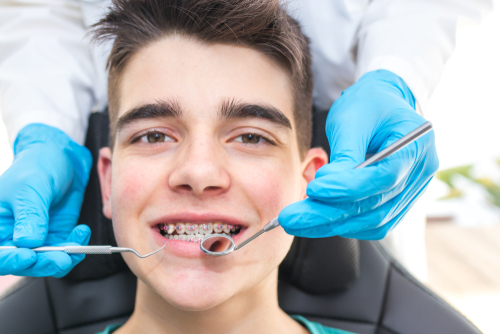Are you thinking of getting orthodontic treatment? You don’t like the state of your smile but are embarrassed to be seen wearing braces? Have you always wanted to improve the appearance of your teeth but have no idea what different types of treatment are available to achieve this? Don’t worry anymore, because we will give you the answer to all your questions.
Until relatively recently, the only orthodontic treatment available and which most people, whether they were children or adults, had to undergo was traditional orthodontics, more popularly known as “braces”. Fortunately, thanks to research and advances in technology, new orthodontic treatments have been developed that are much more modern and have all sorts of advantages over their predecessors, with invisible orthodontics being the most prominent and the type of orthodontics that everyone wants to wear today.

However, both types of orthodontics are equally effective? What are the main differences between traditional orthodontics and Invisalign? What should I consider when choosing between one model or the other? Below, to help you solve all these questions, we will explain the main characteristics of both orthodontics and their main differences.
Here we go!
Invisible Orthodontics
Invisible orthodontics, also known as Invisalign, is the most revolutionary dental aesthetic treatment of the last 20 years. The reason for such tremendous success? Its discretion, ease of use, and comfort. If you need some orthodontic work done, we recommend the people over at Village Dental NYC.
This type of orthodontics works from a series of invisible aligners, very similar to dental braces used at night, which the orthodontist will create from a 3D scan of our mouth and that we can take off and put on ourselves without the help of a dentist.
How does it work?
The operation of invisible orthodontics is really simple and different from anything seen before in this type of treatment since in this case, the dentist will not have to do anything more than making aligners for us and check their effects, since it will be the aligners themselves that will exert moderate pressure on our teeth progressively to return us to an ideal position.
Benefits
Discretion
Of course, when it comes to talking about the advantages of this type of orthodontics we have to talk about its discretion, since no one will notice we are wearing it unless we tell them. This makes it the preferred orthodontic treatment for the more adult population who do not want other people to know they are wearing dental braces.
Safety
Apart from the aesthetic factor, invisible orthodontics will also provide us with a plus of comfort and security against possible dental diseases, since by being able to remove it to brush our teeth and eat we will be able to prevent the development of gingivitis or dental caries, both very common complications of the most convenient orthodontic treatment.
Conventional Orthodontics
Traditional orthodontics is also known as “brackets” is that in which the dentist fixes to the enamel of our teeth a brace and uncomfortable system of wires and metal brackets to correct our smile little by little.
How does it work?
The way traditional orthodontics works consists of exerting moderate pressure every certain period of time on the brackets that the dentist has fixed to our teeth temporarily, which can be somewhat painful but which manages to gradually reposition our teeth and return them to an ideal position.
The duration of this treatment can vary depending on the severity of each case, but it usually lasts between 16 and 24 months. In any case, each case will have its own peculiarities and this will determine the follow-up plan of treatment and its duration.
Benefits
Efficiency
In spite of being much more eye-catching and uncomfortable to wear orthodontics, braces have as their main benefit their high percentage of effectiveness. As it is a treatment that requires greater clinical supervision and in which the whole process is carried out mechanically by the orthodontist, the margin of error is minimal and the results are always as expected.
